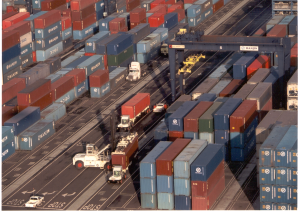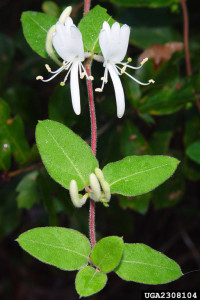 trade transports many invasive species
trade transports many invasive species
Containers at Long Beach, California; courtesy of the Port Authority
In an article published recently in Nature Communications , Hanno Seebens and 44 coauthors show that the rate of new introductions of alien species has risen rapidly since about 1800 – and shows no sign of slowing down. See a summary of the article with revealing graphs here .
Through analysis of a database covering 45,813 first records of 16,926 alien species established in 282 distinct geographic regions, the authors determined that the number of new species reports reached a maximum of 585 in 1996 (or an average of more than 1.5 sightings per day).
Of course, whether a species’ introduction is detected depends on a variety of factors. One of the most important is the species’ impact – or lack thereof! – on economically important resources – this determines whether the species gets noticed. Furthermore, detection usually happens some time after a species’ actual introduction. And, regardless of factors motivating human attention, some types of species are more easily detected than others. All these factors skew the findings. Because many introductions are not detected, Seebens et al. note, their data underestimate actual introductions.
The authors found that the adoption of national and international biosecurity measures during the 20th century have slowed introductions – but they are not yet sufficiently effective. Most notably, numbers of reported new introductions of fish and mammals have decreased since the early 1950s. Of course, introductions of these taxa are usually the result of deliberate decisions, usually by authorities. It is encouraging that authorities appear to be getting the message that adding new species to an ecosystem is a risky enterprise.
 Japanese honeysuckle; courtesy of Bugwood.org
Japanese honeysuckle; courtesy of Bugwood.org
However, not all deliberate introductions have been curbed. Seebens et al. were surprised to see that vascular plant species introductions remained at such a high rate throughout the 20th century. Introductions of birds and reptiles also continue to rise, largely as pets in countries with strengthening economies.
For those plants and animals that are introduced primarily accidentally as stowaways on transport vectors or contaminants of commodities (e.g., algae, insects, crustaceans, molluscs and other invertebrates), Seebens et al. found a strong correlation between their spread and the market value of goods imported into the region of interest.
Having noted that almost all biosecurity efforts are not yet slowing introductions adequately, Seebens et al. point to New Zealand as the exception. That country adopted the Biosecurity Act in 1993 and the Hazardous Substances and New Organisms Act in 1996.
Although 20 years is a short period to gauge a policy’s efficacy – especially given time lags in detecting introductions – Seebens et al. say the stringent new policy appears to be succeeding. They found a significant decline in the number of new alien plants detected in New Zealand since the 1990s. New Zealand’s laws rely on a “white list” of permitted species rather than the more usual “black list” of prohibited species. New Zealand requires a risk assessment before a decision is made to allow any new species to be brought into the country.
Of course, such an approach does not apply easily to the taxa most often introduced as unintended hitchhikers on, or as contaminants of, imported goods, packaging, or transport vehicles – such as tree-killing insects and diseases. The paper notes that existing biosecurity regimes have not slowed down the accumulation of alien species introductions overall, but especially those arriving mainly accidentally, such as invertebrates and pathogens.
As a consequence, Seebens et al. expect that the numbers of new alien species will continue to increase.
I have previously blogged about other studies that show continuing introductions of forest pests and other specific taxonomic groups. See blogs about (1) 2014 IUCN report on invasive species threats to World Heritage sites; (2) IUCN analysis of red-book-listed species – causes of endangerment; (3) rate of new plant pests being detected in US; (4) Jung et al. on Phytophthoras in Europe; (5) Zamir’s critique of international the phytosanitary system; (6) Klapwjik et al. on European efforts to strengthen regulations governing movement of living plants; (7) ISPM#15 11th anniversary.
Other recent studies have also examined the bioinvasion situation for the whole Earth or major regions. Liebhold et al. 2016 studied insect assemblages in 20 regions around the world. They found that which insect orders are present in a particular region differs completely depending on whether one is looking at native or at nonindigenous assemblages. The authors believe that difference is largely caused by the varying probability that an insect taxon can take advantage of one or more high-volume invasion pathways – such as trade in agricultural products, movement of plants by international travelers, shipments of stored grain, trade in living plants, hitchhiking (e.g. on the outside of shipping containers) and wood packaging. Pathway association appeared to be more important than insects’ life-history traits, which affect their ability to establish in a new ecosystem.
Maartje J. Klapwijk and several colleagues note that growing trade in living plants and wood products has brought a rise in non-native tree pests becoming established in Europe. The number of alien invertebrate species has increased two-fold since 1950; the number of fungal species has increased four-fold since 1900.
Jung et al. (2015) studied the presence of Phytophthora pathogens in nurseries in Europe. They found
- Two-thirds of the Phytophthora taxa detected in European nurseries by the present study were unknown to science before 1990.
- None of the 59 putatively exotic Phytophthora taxa detected in the present study had been intercepted at European ports of entry.
- Spread of the quarantine organism ramorum has not been halted despite the presence of strict quarantine regulations.
I will post a blog examining introduction rates for tree-killing insects and pathogens specifically in the near future. In the meantime, see the published studies listed below as well as my earlier blogs and fact sheets posted here .
Aukema, J.E., B. Leung, K. Kovacs, C. Chivers, K. O. Britton, J. Englin, S.J. Frankel, R. G. Haight, T. P. Holmes, A. Liebhold, D.G. McCullough, B. Von Holle.. 2011. Economic Impacts of Non-Native Forest Insects in the Continental United States PLoS One September 2011 (Volume 6 Issue 9)
Aukema, J.E., D.G. McCullough, B. Von Holle, A.M. Liebhold, K. Britton, & S.J. Frankel. 2010. Historical Accumulation of Nonindigenous Forest Pests in the Continental United States. Bioscience. December 2010 / Vol. 60 No. 11
Haack RA, Britton KO, Brockerhoff EG, Cavey JF, Garrett LJ, et al. (2014) Effectiveness of the International Phytosanitary Standard ISPM No. 15 on Reducing Wood Borer Infestation Rates in Wood Packaging Material Entering the United States. PLoS ONE 9(5): e96611. doi:10.1371/journal.pone.0096611
Leung, B., M.R. Springborn, J.A. Turner, E.G. Brockerhoff. 2014. Pathway-level risk analysis: the net present value of an invasive species policy in the US. The Ecological Society of America. Frontiers of Ecology.org
Liebhold, A.M., T. Yamanaka, A. Roques, S. Augustin, S.L. Chown, E.G. Brockerhoff, P. Pysek. 2016. Global compositional variation among native and nonindigenous regional insect assemblages emphasizes the importance of pathways. Biological Invasions (2016) 18:893–905
Lovett, G.M., M. Weiss, A.M. Liebhold, T.P. Holmes, B. Leung, K.F. Lambert, D.A. Orwig , F.T. Campbell, J. Rosenthal, D.G. McCullough, R. Wildova, M.P. Ayres, C.D. Canham, D.R. Foster, S.L. LaDeau, and T. Weldy. 2016. Nonnative forest insects and pathogens in the United States: Impacts and policy options. Ecological Applications, 0(0), 2016, pp. 1–19. DOI 10.1890/15-1176.1
Posted by Faith Campbell
We welcome comments that supplement or correct factual information, suggest new approaches, or promote thoughtful consideration. We post comments that disagree with us — but not those we judge to be not civil or inflammatory.